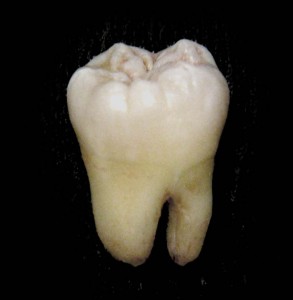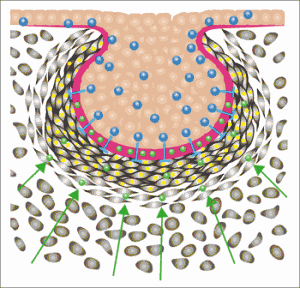How do cells figure out how to build three-dimensional organs with multiple kinds of tissues? A group of engineers, geneticists, biochemists and cell biologists at Children’s Hospital Boston and Harvard’s Wyss Institute for Biologically Inspired Engineering sunk their teeth into this mystery – starting, in fact, with the tooth.
Scientists have known for more than a century that the growth of many organs (including tooth, cartilage, bone, muscle, tendon, kidney and lung) begins with the formation of a compact cell mass called “condensed mesenchyme.” But what makes this mass form to begin with? Until now, no one knew.
The Wyss-Children’s team, part of the Systems-Based Consortium for Organ Design & Engineering, found that simple mechanics play a critical role. They showed that mechanically compressing certain cells, causing them to change shape, is enough to spark the genetic activity that drives tooth development. In response to compression, the same genes that stimulate cell migration turn on and trigger tooth formation, causing connective-tissue cells to migrate towards each other and pack tightly together.
Led Don Ingber, Wyss’s founding director, and Tadanori Mammoto, research fellow in the Vascular Biology Program at Children’s, the team was able to create a whole tooth — complete with enamel and dentin — by squeezing connective-tissue cells between two rubber plates and implanting that tissue in a mouse.
Ingber, also the Judah Folkman Professor of Vascular Biology at Children’s, believes that genes and molecules only partially explain biology and disease. He’s spent much of his career showing that mechanical forces influence cell behavior – including biochemical activity — by pushing and pulling on the cell’s internal scaffolding or cytoskeleton.
This perspective has informed Ingber’s many contributions to tissue engineering – including a proposed a tissue-engineering approach to breast cancer, which he sees as a breakdown of normal tissue development (as he explains in this YouTube video).
In the case of teeth, Ingber and his colleagues hope to engineer synthetic implants that, when placed in the mouth, would produce the same mechanical transformations needed to sprout a new tooth. But the longer-term goal is to harness mechanobiology to grow more complex organs, such as a liver or kidney, mimicking what happens naturally in embryonic development.
“We hope to apply these lessons to develop new bio-inspired inductive materials that will ultimately help the millions of people who suffer from organ failure—and help transform medicine in the process,” Ingber says.
Some might say Ingber’s team has bit off more than it can chew. Still, this approach could prove to have teeth.









